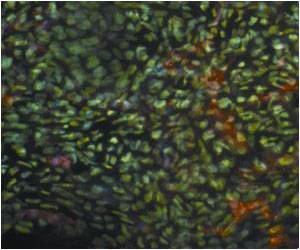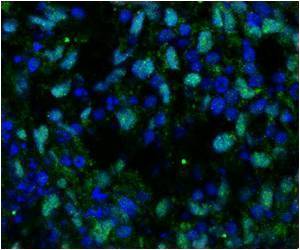Study shows how a key protein gets to the right spot to launch electrical impulses that enable communication of nerve signals to and from the brain.

For example, if your finger touches a hot stove, nerve impulses support quick communication between nerve cells in the hand and the brain so you avoid a serious burn.
This new research reveals a part of the process that was not understood before, about how a "molecular motor" helps move the impulse generator to its proper place on an axon to perform this vital job.
"This study is solving a very fundamental question," said Chen Gu, assistant professor of neuroscience at The Ohio State University and lead author of the paper. "If these channel proteins don't get into the nerves, nothing happens. They have to be correctly delivered and inserted into the axon to be functional."
The research is published online in the journal Developmental Cell and will appear in the Jan. 27 print issue.
Like most proteins, the molecule that initiates nerve impulses is made in the cell body of a neuron, or nerve cell. But this protein, called a sodium ion channel, does its work on and between insulated segments of axons. Since nerve impulses were discovered in the 1950s, scientists have been unable to describe how the sodium channel gets to where it needs to be to initiate these electrical signals.
Advertisement
The research could help explain the deepest origins of many neurological disorders – ranging from multiple sclerosis and Parkinson's disease to injuries of the spinal cord and brain – that are traced to malfunctioning or degenerated axons and the resulting improper electrical signaling.
Advertisement
The research team accidentally found the binding between the anchor and motor proteins several years ago, which eventually led to the discovery of this transporting mechanism concerning the sodium channel. This channel is difficult to study because it is a large and complicated molecule relative to other players in the process.
The anchor protein, called ankyrin-G, is known to be tethered to sodium channel proteins once they reach axons. It is an adapter protein that helps other molecules connect, and is concentrated on axons close to the cell body as well as in regions called the nodes of Ranvier, which are gaps between axon segments (think of twisted casings between sausage links). These gaps are important to signal transmission because nerve impulses must jump across them to maintain the flow of communication.
The motor protein, called kinesin-1, hooks up with ankyrin-G at the same time ankyrin-G is attached to the sodium channel. As a motor protein, kinesin-1 can produce mechanical force by making use of a specific energy source in cells. In an unusual scenario, both the sodium channel and kinesin-1 can connect with ankyrin-G at the same time using multiple binding sites.
"This allows ankyrin-G to bind to the sodium channel and the motor protein simultaneously so they can form a complex. Ankyrin-G plays its adapter role by loading the sodium channel onto the motor protein. Then the motor protein can act like a cargo carrier, transporting the sodium channel to the axon," Gu said.
The researchers confirmed this process by observing the three proteins traveling together along an axon using live-cell imaging, as well as in studies using animals. Mice missing ankyrin-G in the cerebellum lacked the ability to move the sodium channels, and injecting a piece of the kinesin-1 molecule into the brains of normal mice interfered with the three-way protein interaction, also leaving the sodium channel proteins stuck in the cell body.
"We have identified protein-to-protein interactions between three very important and evolutionarily conserved molecules. We also found that if we damage the interaction using different strategies, the sodium channel won't be transported," Gu said.
"Mutations in the genes encoding the three proteins can lead to some neurological and mental disorders in humans. In many other diseases, the primary defect initiated by something else can alter the function of these three proteins – and particularly sodium channel transport and function – and ultimately disrupt the nerve impulse," he said. "If the sodium channel can't conduct the nerve impulse anymore, that gives rise to symptoms of neurological disorders."
Source-Eurekalert











